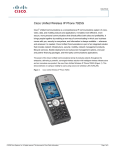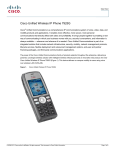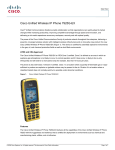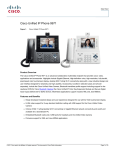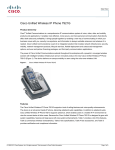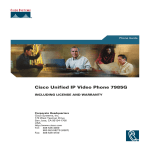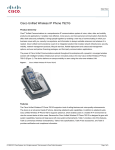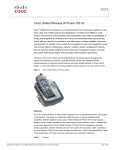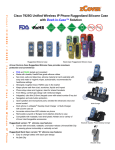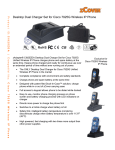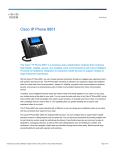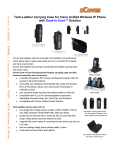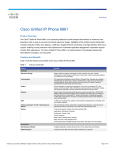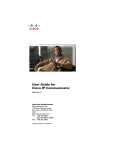Download Cisco 7925G 6lines LCD Wi-Fi Wireless handset Black, Yellow
Transcript
Data Sheet Cisco Unified Wireless IP Phone 7925G-EX ® Cisco Unified Communications Solutions enable collaboration so that organizations can quickly adapt to market changes while increasing productivity, improving competitive advantage through speed and innovation, and delivering a rich-media experience across any workspace, securely and with optimal quality. The power of the Cisco Unified Communications Family of products extends throughout the enterprise, delivering a powerful, converged wireless solution with intelligent wireless infrastructure and an innovative new product: the new Cisco Unified Wireless IP Phone 7925G-EX (Figure 1). This device is certified for potentially explosive environments in the gas, oil, and chemical production fields as well as dust-filled environments. ATEX and CSA Approved The Cisco Unified Wireless IP Phone 7925-EX is ATEX Zone 2 certified. Zone 2 is defined as an area in which an explosive gas atmosphere is not likely to occur in normal operation and if it does occur, is likely to do so only infrequently and will exist for a short period only (for example, less than 10 hours per year). The phone is also CSA Class 1 Division II certified. Class 1 is a location where a quantity of flammable gas or vapor sufficient to produce an explosive or ignitable mixture may be present in the air. Division II is a location where a classified hazard does not normally exist but is possible under abnormal conditions. Figure 1. Cisco Unified Wireless IP Phone 7925G-EX Features The Cisco Unified Wireless IP Phone 7925G-EX delivers all the capabilities of the Cisco Unified Wireless IP Phone 7925G with the ruggedness and resiliency that is certified for deployment in environments such as chemical and manufacturing plants, utilities, and oil refineries. © 2009-2011 Cisco Systems, Inc. All rights reserved. This document is Cisco Public Information. Page 1 of 7 Data Sheet Features include: ● Atmospheres Explosibles (ATEX) Zone 2/Class 22 certification prevents ignition of surrounding gas vapors by the phone. ● Canadian Standards Association (CSA) Division 2/Class 1 certification provides access to mobile collaborative communications. ● IP64 rating for superior and splashing water resistance adds resiliency. ● Industry-standard yellow styling offers fast recognition if an emergency occurs. ● The phone meets 802.11a/b/g standards for voice over WLAN (VoWLAN) communications support. ● The phone supports third-party Bluetooth 2.0 headsets for added freedom. ● The large 2-inch color (176 x 220 pixels) display makes viewing easy. ● The phone offers exceptional voice quality with High-definition (HD) voice. ● A built-in full-duplex speakerphone offers high-quality hands-free communications. ● The Applications key provides direct access to XML applications such as push-to-talk and Lone Worker. ● Extended-life batteries deliver a minimum of 13 hours talk time and up to 240 hours of standby time. Table 1 lists the features, Table 2 summarizes wireless characteristics, Table 3 lists specifications, and Table 4 provides certification and compliance information about the Cisco Unified Wireless IP Phone 7925G-EX. Table 1. Features Features Features of Cisco Unified Wireless IP Phone 7925G-EX Description ● Six line appearances ● Abbreviated dialing ● Adjustable ringing and volume levels ● Adjustable display brightness and timeout ● Any-key answer ● Audible and vibrating ringers ● Auto-answer ● Auto-detection of headset and auto-answer from headset ● Automatic keypad lock ● Barge ● Callback ● Call forward ● Call history lists ● Call park ● Call pickup ● Call timer ● Call waiting ● Caller ID ● cBarge ● Corporate directory ● Conference ● Direct transfer ● Extension mobility service ● Fast-dial service ● Group call pickup ● Hold ● Hotkey for keypad lock, vibration and ring toggle, and voicemail access ● Immediate divert ● Join ● Last-number redial ● Malicious-caller ID ● Message-waiting indicator ● Meet-me conference © 2009-2011 Cisco Systems, Inc. All rights reserved. This document is Cisco Public Information. Page 2 of 8 Data Sheet Features Description ● Multilevel precedence and preemption (MLPP) ● Music on hold ● Mute ● Network profiles (automatic) ● On- and off-network distinctive ringing ● OPickUp ● Personal directory ● Predialing before sending ● Privacy ● Quality report tool (QRT) ● Redial ● Ring tone per line appearance ● Service URL ● Shared line ● Time and date display ● Transfer Buttons ● Two softkey buttons to access screen-based applications, features, and functions ● Application button that can support push-to-talk using XML ● Mute ● Speakerphone ● Five-way navigation support ● Volume control ● Send button and Power/End button Display 2-in. (5-cm) color display with 176- x 220-pixel resolution LED Ring, message waiting, and charging LED Protocol support ● Skinny Client Control Protocol (SCCP) ● Cisco Unified Communications Manager Versions 4.1, 4.2, 4.3, 5.1, 6.0, 6.1, 7.0, and later ● Cisco Unified Communications Manager Express Version 4.3 and later ● Cisco Unified Survivable Remote Site Telephony (SRST) Version 4.3 and later Cisco Compatible Extensions Cisco Compatible Extensions Version 4 Extensible language XML Codec support G.711a, G.711u, G.729a, G.729ab, G.722, and Internet Low Bitrate Codec (iLBC) audio-compression codecs Configuration options ● Dynamic Host Configuration Protocol (DHCP) client or static configuration ● Support for online firmware upgrades using Trivial File Transfer Protocol (TFTP) ● Domain Name System (DNS) Network features ● Cisco Discovery Protocol ● Transparent secure roaming ● Provisioning of network parameters through DHCP Security features ● Certificates ● Image authentication ● Device authentication ● File authentication ● Signaling authentication ● Secure Cisco Unified SRST ● Media encryption using Secure Real-Time Transport Protocol (SRTP) ● Signaling encryption using Transport Layer Security (TLS) Protocol ● Certificate authority proxy function (CAPF) ● Secure profiles ● Encrypted configuration files Cryptography is not enabled by default and may only be enabled through a cryptographically enabled CUCM. Provisioning and management ● Web server for configuration and statistics ● Capability to disable local phone settings ● Quality-of-service (QoS) reporting: Jitter, delay, dropped packets, and latency on a per-call basis ● Real-Time Control Protocol (RTCP) support and monitoring ● Syslog ● Wavelink Avalanche (http://www.wavelink.com) © 2009-2011 Cisco Systems, Inc. All rights reserved. This document is Cisco Public Information. Page 3 of 8 Data Sheet Features Description Deployment tools Integrated site survey tool Language support Bulgarian, Catalan, Chinese, Croatian, Czech, Danish, Dutch, English, Finnish, French, German, Greek, Hungarian, Italian, Japanese, Korean, Norwegian, Polish, Portuguese, Romanian, Russian, Serbian, Slovak, Slovenian, Spanish, and Swedish Table 2. Wireless Characteristics of Cisco Unified Wireless IP Phone 7925G-EX Item Description Protocol IEEE 802.11a, 802.11b, and 802.11g Frequency band and operating FCC: (-A) channels ● 2.412–-2.462 GHz; 11 channels ● 5.15–-5.25 GHz Unlicensed National Information Infrastructure (UNII-1), 5.25–-5.35 GHz (UNII-2), and 5.725–5.825 GHz (UNII-3); 12 channels ● 5. 47–-5.725 GHz; 11 channels ETSI: (-E) ● 2.412–-2.472 GHz; 13 channels ● 5.15–-5.725 GHz; 19 channels Japan: (-P) ● 2.412–-2.472 GHz; 13 channels Orthogonal Frequency Division Multiplexing (OFDM) ● 2.412–-2.484 GHz; 14 channels Complementary Code Keying (CCK) ● 5.15–-5.725 GHz; 19 channels Rest of World: (-W) ● Uses IEEE 802.11d to identify band ranges and channels Support mode ● IEEE 802.11a ● IEEE 802.11b/g ● Autosensing, IEEE 802.11b/g preferred over IEEE 802.11a ● Autosensing, IEEE 802.11a preferred over IEEE 802.11b/g ● Received signal strength indicator (RSSI) (default) Data rates Nonoverlapping channels IEEE 802.11a: IEEE 802.11b: IEEE 802.11g: 6, 9, 12, 18, 24, 36, 48, and 54 Mbps 1, 2, 5.5, and 11 Mbps 6, 9, 12, 18, 24, 36, 48, and 54 Mbps ● IEEE 802.11a: Up to 23 (including radar channels) ● IEEE 802.11b/g: 3 (Japan uses 4) (Bluetooth 2.0 also uses the 2.4-GHz spectrum, so IEEE 802.11a is recommended when using Bluetooth 2.0) Wireless modulation ● IEEE 802.11a: OFDM ● IEEE 802.11b: Direct sequence spread spectrum (DSSS) ● IEEE 802.11g: OFDM and DSSS Receiver sensitivity (typical) Transmitter output power IEEE 802.11a: ● 6 Mbps: -91 dBm IEEE 802.11b: ● 1 Mbps: -96 dBm v802.11g: ● 6 Mbps: -91 dBm ● 9 Mbps: -90 dBm ● 12 Mbps: -88 dBm ● 2 Mbps: -95 dBm ● 5.5 Mbps: -90 dBm ● 9 Mbps: -90 dBm ● 12 Mbps: -87 dBm ● 18 Mbps: -86 dBm ● 24 Mbps: -82 dBm ● 11 Mbps: -87 dBm ● 18 Mbps: -86 dBm ● 24 Mbps: -82 dBm ● 36 Mbps: -80 dBm ● 48 Mbps: -77 dBm ● 36 Mbps: -80 dBm ● 48 Mbps: -77 dBm ● 54 Mbps: -75 dBm ● 54 Mbps: -76 dBm IEEE 802.11a OFDM: ● 40 mW (16 dBm) ● 32 mW (15 dBm) ● 20 mW (13 dBm) ● 8 mW (9 dBm) ● 3.2 mW (5 dBm) ● 1 mW (0 dBm) IEEE 802.11b CCK: ● 50 mW (17 dBm) ● 20 mW (13 dBm) ● 8 mW (9 dBm) ● 3.2 mW (5 dBm) ● 1 mW (0 dBm) © 2009-2011 Cisco Systems, Inc. All rights reserved. This document is Cisco Public Information. IEEE 802.11g OFDM: ● 40 mW (16 dBm) ● 32 mW (15 dBm) ● 20 mW (13 dBm) ● 8 mW (9 dBm) ● 3.2 mW (5 dBm) ● 1 mW (0 dBm) Page 4 of 8 Data Sheet Item Description Range (stated ranges are from measured open-site range testing) IEEE 802.11a: ● 6 Mbps: 604ft (184m) ● 9 Mbps: 604 ft (184m) ● 12 Mbps: 551 ft (168m) ● 18 Mbps: 545 ft (166m) ● 24 Mbps: 512 ft (156m) IEEE 802.11b: ● 1 Mbps: 1,010 ft (308m) ● 2 Mbps: 951 ft (290m) ● 5.5 Mbps: 919 ft (280m) ● 11 Mbps: 902 ft (275m) IEEE 802.11g: ● 6 Mbps: 709 ft (216m) ● 9 Mbps: 650 ft (198m) ● 12 Mbps: 623 ft (190m) ● 18 Mbps: 623 ft (190m) ● 24 Mbps: 623 ft (190m) ● 36 Mbps: 420 ft (128m) ● 48 Mbps: 322 ft (98m) ● 36 Mbps: 495 ft (151m) ● 48 Mbps: 413 ft (126m) ● 54 Mbps: 289 ft (88m) ● 54 Mbps: 394 ft (120m) Ranges and actual throughput vary based on numerous environmental factors, so individual performance may differ. Access point support ● Cisco 500 Series Wireless Express Access Points ● Cisco Aironet® 1000 Series Lightweight Access Point ● Cisco Aironet 1100 Series Access Point ● Cisco Aironet 1130 AG Series ● Cisco Aironet 1200 Series ● Cisco Aironet 1230 AG Series ● Cisco Aironet 1240 AG Series Required versions: ● Cisco Wireless LAN Controller (lightweight) Minimum: Version 4.0.217.0 Recommended: Version 5.1.151.0 or later ● Cisco IOS® Software access points (autonomous) Minimum: Version 12.3(8)JEA Recommended: Version 12.3(4g)JA1 or later ● Cisco Aironet 1250 Series ● Cisco Aironet 1300 Series Wireless security QoS Authentication: ● Cisco Wireless Security Suite IEEE 802.1X ● Lightweight Extensible Authentication Protocol (LEAP) authentication ● Protected Extensible Authentication Protocol (PEAP) MS-CHAP Version 2 ● Extensible Authentication Protocol and Flexible Authentication with Secure Tunneling (EAP-FAST) ● Extensible Authentication Protocol and Transport Layer Security (EAP-TLS) ● Wi-Fi Protected Access (WPA) Versions 1 and 2: Personal and Enterprise ● Cisco Centralized Key Management (CCKM) Encryption: ● 40-bit and 128-bit static Wired Equivalent Privacy (WEP) ● Temporal Key Integrity Protocol (TKIP) and Message Integrity Check (MIC) ● Advanced Encryption Standard (AES) IEEE 802.11e and Wi-Fi Multimedia (WMM) ● Traffic Specification (TSPEC) ● Enhanced Distributed Channel Access (EDCA) ● QoS Basic Service Set (QBSS) Radar detection Power save mode Table 3. Dynamic frequency selection (DFS) and transmit power control (TPC) according to IEEE 802.11h ● U-APSD ● Power Save Poll (PS-Poll) Specifications of Cisco Unified Wireless IP Phone 7925G-EX Item Description Dimensions (H x W x D) 5.0 x 2.0 x 0.8 in. (12.7 x 5.2 x 2.0 cm) Weight 4.8 to 5.0 oz (138 to143g) depending on battery Battery ● Standard lithium-ion (Li-ion) battery life: Up to 9.5 hours talk time and 180 hours standby time ● Extended Li-ion battery life: Up to 13 hours talk time and 240 hours standby time Note: Actual battery life varies significantly based on environmental factors and Bluetooth use. Input power Operating temperature ● Phone: 100 to 240 VAC, ~0.2A, and 50 to 60 Hz ● AC adapters (by geographical region) 14 to 122°F (-10° to 50°C) © 2009-2011 Cisco Systems, Inc. All rights reserved. This document is Cisco Public Information. Page 5 of 8 Data Sheet Item Description Storage temperature –22 to 140°F (–30 to 60°C) Relative humidity 10 to 95% (noncondensing) Vibration 1.5 Grms maximum, 0.1 in. (2.5 mm) double amplitude at 0.887 octaves per minute from 5–500–5 Hz sweep, and 10-minute dwell on three major peaks in each of the three major mutually perpendicular axes Thermal shock –22°F (–30°C) 24 hours; 158°F (70°C) 24 hours Altitude Certified for operation: 0 to 6500 ft (0 to 2 km) Endurance ● IP64 ● MIL-STD-810F, Method 516.5, Procedure I Headset ● Wireless: Bluetooth 2.0 EDR ● Wired: 2.5 mm (4-conductor tri-band) Connector Table 4. Mini USB Certification and Compliance Item Safety Description ● UL 60950 ● CSA 22.2 No.60950 ● EN 60950 ● IEC 60950 ● AS/NZS 60950 ● IEC 60529 (IP 54) ● ATEX Zone 2 ● CSA Division I Class II Electromagnetic compatibility and electromagnetic interference (EMC/EMI) ● 47 CFR Part 15 Class B ● ICES-003 Class B ● EN 55022 Class B ● AS/NZS CISPR 22 Class B ● CISPR 22 Class B ● VCCI Class B ● EN 61000-3-2 ● EN 61000-3-3 ● KN 22 ● EN 55024 ● EN 50082-1 ● EN 61000-6-1 ● EN 300386 ● EN 60601-1-2 ● KN Immunity Series Telecom ● FCC Part 68 (CFR) (HAC) ● NZ PTC 220 DR ● AS/ACIF S004 and AS/ACIF S040 (Australia) ● TIA 810-B and TIA 920-A Radio ● USA: FCC Part 15.247 (2.4 GHz), FCC Part 15.407 (5 GHz), and FCC Part 2 ● Canada: RSS-210 ● Japan: ARIB STD-T66 (2.4 GHz), and ARIB STD-T70 and T71 (4.9/5 GHz) ● ETSI : EN 300.328 (2.4 GHz) and EN 301.893 (5 GHz) ● Australia and New Zealand: AS/NZS 4268 ● Singapore: IDA TS SRD ● Hong Kong: HKTA1039 RF exposure ● OET-65C (01-01) ● ANSI C95.1 (91) ● RSS-102 ● ACA Radio Communications (Electromagnetic Radiation - Human Exposure) Standard 2003 ● EN 50360 ● EN 301489-1 © 2009-2011 Cisco Systems, Inc. All rights reserved. This document is Cisco Public Information. Page 6 of 8 Data Sheet Item Description ● EN 301489-17 Ordering Information Note: All Cisco Unified IP Phones require the purchase of a phone technology license, regardless of the call protocol being used. The Cisco Unified Wireless IP Phone 7925G-EX is only offered in the World mode, and will require an Access Point which supports 802.11d to indicate which channels are to be used by the Cisco Unified Wireless IP Phone 7925G-EX. Tables 5 and 6 provide ordering information for the Cisco Unified Wireless IP Phone 7925G-EX. Table 5. Product and License Ordering Information Part Number Description CP-7925G-EX-K9 Cisco Unified Wireless IP Phone 7925G-EX World Mode ; Cisco Unified Communications Manager and Cisco Unified Communications Manager Express User License Required; Battery/Power Supply Not Included SW-CCM-UL-7925G Cisco Unified Communications Manager User License for single Cisco Unified Wireless IP Phone 7925G SW-CCME-UL-7925 Cisco Unified Communications Manager Express User License for single Cisco Unified Wireless IP Phone 7925G Table 6. Optional Accessories Ordering Information Part Number Description CP-BATT-7925G-STD= Cisco Unified Wireless IP Phone 7925G Battery, Standard CP-BATT-7925G-EXT= Cisco Unified Wireless IP Phone 7925G Battery, Extended CP-PWR-7925G-AU= Cisco Unified Wireless IP Phone 7925G Power Supply for Australia CP-PWR-7925G-CE= Cisco Unified Wireless IP Phone 7925G Power Supply for Central Europe CP-PWR-7925G-JP= Cisco Unified Wireless IP Phone 7925G Power Supply for Japan CP-PWR-7925G-NA= Cisco Unified Wireless IP Phone 7925G Power Supply for North America CP-PWR-7925G-UK= Cisco Unified Wireless IP Phone 7925G Power Supply for United Kingdom CP-PWR-7925G-AR= Cisco Unified Wireless IP Phone 7925G Power Supply for Argentina Warranty Cisco Unified IP Phones are covered by a Cisco standard 1-year replacement warranty. A Cisco SMARTnet® optional service agreement is available for the Cisco Unified Wireless IP Phone 7925G-EX and Cisco Unified Wireless IP Phone 7925G-EX Multi-Charger only, not for other accessories such as batteries. Note: This product is not a medical device and may use an unlicensed frequency band that is susceptible to interference from other devices or equipment. Cisco Unified Communications Services and Support Using the Cisco Lifecycle Services approach, Cisco and our partners offer a broad portfolio of end-to-end services to support the Cisco Unified Communications System. These services are based on proven methodologies for deploying, operating, and optimizing IP Communications solutions. Initial planning and design services, for example, can help you meet aggressive deployment schedules and reduce network disruption during implementation. Operate services reduce the risk of communications downtime with expert technical support, and optimize services enhance solution performance for operational excellence. Cisco and our partners offer a system-level service and support approach that can help you create and maintain a resilient, converged network that meets your business needs. © 2009-2011 Cisco Systems, Inc. All rights reserved. This document is Cisco Public Information. Page 7 of 8 Data Sheet Printed in USA © 2009-2011 Cisco Systems, Inc. All rights reserved. This document is Cisco Public Information. C78-565676-01 02/11 Page 8 of 8








